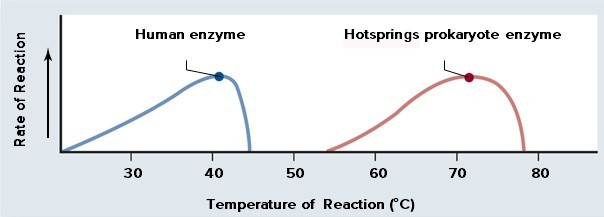Based on the graph below, what are the optimal temperatures for the human enzyme and the hotsprings prokaryote enzyme?
A. The optimal temperature for the human enzyme is 46°C; the optimal temperature for the hotsprings prokaryote enzyme is 79°C.
B. The optimal temperature for the human enzyme is 35°C; the optimal temperature for the hotsprings prokaryote enzyme is 65°C.
C. The optimal temperature for the human enzyme is 40°C; the optimal temperature for the hotsprings prokaryote enzyme is 72°C.
D. The optimal temperature for the human enzyme is 30°C; the optimal temperature for the hotsprings prokaryote enzyme is 60°C.
Answer: C
You might also like to view...
What basal transcription factor is most often affected by regulatory transcription factors?
A. TFIIB B. TFIID C. TFIIE D. TFIIF
Double fertilization means that _____
A) flowers must be pollinated twice to yield fruits and seeds B) one sperm is needed to fertilize the egg, and a second sperm is needed to fertilize the polar nuclei C) the egg of the embryo sac is diploid D) every sperm has two nuclei
During fermentation of a food product, some microorganisms create their own environment to minimize food spoilage. An example is ________, which produce(s) acidic by-products during sauerkraut production
a. Aspergillus oryzae b. Lactobacillus spp. c. Saccharomyces cerevisiae d. Zymomonas mobilis
Please match the cell types with the statements that most accurately describe them to test your understanding of prokaryotic cells, eukaryotic cells, and viruses. Does not contain organelles but can replicate independently via binary fission
A) Prokaryotic cells B) Eukaryotic cells C) Viruses D) Both eukaryotic and prokaryotic cells E) Prokaryotic cells, eukaryotic cells and viruses